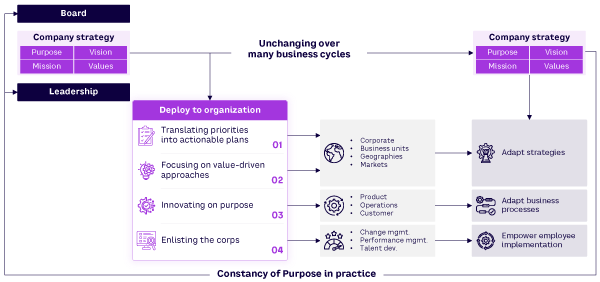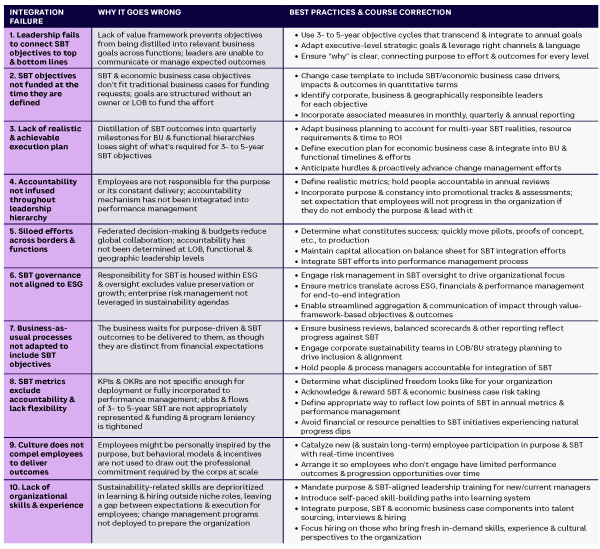AMPLIFY VOL. 38, NO. 1

Sustainable business transformation (SBT) continues to be a focus in the private sector and a challenge to deliver successfully at scale. The board or C-suite may consider the investment too high, the outcomes intangible, the revenue growth limited. Or perhaps the political landscape changes so drastically that companies wonder, “Why even bother?”
However, by abandoning SBT efforts (or not embarking on the journey) some companies are leaving real financial results on the table in the form of top-line growth and bottom-line optimization. Those companies are also opting out of the collective power of SBT by the private sector that is so critical to progressing the United Nations Sustainable Development Goals (UN SDGs).1
Large corporations tend to overlook the fact that successful integration of sustainable business models consistently results in product innovation, new market entry, and commercial longevity — potential financial impacts that should not be ignored. Proven benefits include cultural performance improvement, increased employee retention and progression, improved talent recruitment, and customer loyalty, greatly strengthening the financial business case for SBT.
Companies also overlook the potential for broader economic impact. Harvesting the business value of sustainability for themselves is one thing, but we must not lose sight of the societal and planetary-level economic value that can be derived from the corporate collective. The economic impacts of scaled, private-sector SBT are tremendous.
In fact, a holistic economic business case is a critical piece of any company’s strategic spear. Importantly, the extent to which companies realize the long-term benefits of their economic business case turns on two factors: (1) their ability to derive tangible, measurable value from those sustainability efforts and (2) leadership’s ability to stay the course as the market twists and turns and externalities present peaks and valleys of opportunity and risk.
This brings us back to why so many companies abandon their SBT efforts. They are missing a Constancy of Purpose that serves as a guidepost across business cycles. It’s time to right-size (if not super-size) our SBT expectations by committing to the Constancy of Purpose required to realize it.
Purpose-Driven Leadership Leads to Sustainable Transformation
A strong economic business case doesn’t begin by defining a purpose but by making each individual in the business feel empowered to pursue and accountable for achieving it. This requires infusing the purpose from top to bottom; across sales, marketing, product development, and operations; and from leaders to analysts. Unfortunately, the concept of purpose has been conflated with mission, ambition, values, and other strategies over time (not to mention devalued in the era of “wokeness”), making it difficult to define, let alone achieve.
In this article, we reference purpose as being rooted in sustainability, environmental impact, or an otherwise SDG-aligned, planetary-related outcome(s).
Historically, purpose has served as a “what” or a “why.” In Accelerate, leadership strategist John Kotter calls this “The Big Idea”: a strategic vision, direction, or objective otherwise intended to unify leadership, employees, and customers around a raison d'être.2 This definition holds true in the sense that it can serve as the connective tissue between ambition, effort, and outcomes.
A more novel proposal positions purpose as a “how” that is delivered with constancy:
-
It exists as a bedrock foundation that is unchanging (or changing rarely and minutely over business cycles).
-
It serves as a unifier that carries an organization through the headwinds and tailwinds of our modern polycrisis.
-
Rather than a standalone value driver, it’s an enabler of a larger economic business case that permeates the organization, elevates the brand, and positively impacts society.
-
It’s a tool to adapt to rapidly shifting priorities, market urgencies, and socioeconomic volatility that businesses face with increasing frequency and inconvenient timing.
-
It acts as a cultural catalyst throughout the organization and comes to represent the spirit of “how we do things here,” readying the business to accelerate and adapt at the right time, every time.
Ultimately, purpose can generate a business that possesses cultural empowerment and resilience that is otherwise unattainable. Successful long-term integration of purpose is the key to creating a strong economic business case. This is not accomplished in a single business cycle but over many cycles of change.
Kotter’s attempt at an integration framework to realize The Big Idea centered around a dual operating system in which management hierarchy at the top meets adaptive networks grown organically somewhere in the center. Our framework differs in two ways. First, it is focused on achieving SBT- and SDG-related outcomes. This requires an evolved depth of purpose and the stamina of generations of leadership to reinforce. Second, it pushes the boundaries and spirit of The Big Idea beyond a short-term market opportunity into a broader economic business case — and what some might consider the moral high ground of purpose.
Ultimately, purpose-led people and products produce purposeful profits. These organizations are positioned to achieve SBT, grow sustainably, and meet evolving consumer demands. By simultaneously leveraging purpose as “what,” “why,” and “how,” companies can authentically integrate it into business operations and across the value chain, from product design and go-to-market relationships to leadership development and performance management.
The company’s top leaders must build trust with shareholders, employees, and customers, and purpose must be infused into critical decision-making, especially in times of crisis. If the relationship between purpose and business decisions is not visible with constancy, the company risks becoming a promoter of green or purpose-washing.
Constancy of Purpose Fosters Integration & Longevity
Constancy has been an underutilized transformation lever, primarily because of the difficulty in achieving it. Company leadership must embody the purpose in everything they do over the course of many years. It must be unchanging in the face of executive transitions and both anticipated and unforeseen market events (see Figure 1). It must also be ever-present for employees, customers, and shareholders, motivating them in times of immense opportunity and giving them faith when conditions threaten stability.

Constancy of Purpose provides a robust structure for deploying leadership through multiple business cycles. With constancy, purpose becomes a platform that enables change, empowers resilience, and can be deeply trusted by the organization when difficult decisions must be made.
In organizations with Constancy of Purpose, integration of SBT (and any thematic driver the future may present) is smooth and efficient. Constancy also counteracts short-termism when it comes to prioritization of quarterly or in-year financial goals, fostering long-term, sustainable growth.
Applying Constancy of Purpose well requires some ground rules, boundaries, and trade-offs. Although not an exhaustive list, the concepts below provide critical direction:
-
By no means should purpose be prioritized over (or operate independently from) profit. The opposite is true: companies must find a balanced harmony with financial performance. This is core to achieving constancy.
-
Applying Constancy of Purpose requires a realistic assessment of the risks and potential losses in not only the strategy but also the timeline, milestones, and resources to deliver on the purpose. Although purpose can be a long-term unifier, enabler, and opportunity, the business must also consider the “what” of purpose in traditional operational delivery terms and smaller timescales.
-
The economic business case on which a company’s Constancy of Purpose is built must consider the value of opportunity, the cost of inaction, and value preservation. Incorporating a balanced approach to assessing the economic and financial impacts of purpose-enabled leadership decisions is necessary to achieve constancy. If profits are prioritized in the short term, the cost of inaction or threat to current value drivers might equate to cannibalizing an existing product or new business opportunity elsewhere in the organization, or just beyond the horizon.
-
Constancy of Purpose involves considering the cyclical nature of achieving long-term financial gains and delivering the scaled impacts set out by the economic business case. Anticipating and accepting the short-term outcomes of both internalities and externalities will lend credibility to a company’s (and leader’s) purpose, strengthening the trust required to enable constancy across three- to five-year objectives.
4 Success Enablers
Dow, with one of the earliest public commitments to measurable sustainability goals in 1996; DuPont, which famously appointed the first chief sustainability officer of a publicly traded company in 2004; and Unilever, which announced the Unilever Sustainable Living Plan in 2010 and pursued an operational and product portfolio rebirth, are some of the best examples of constancy in purpose-driven leadership.3-5 Their purpose has become them. This is evident in their early commitment to sustainability and their unwavering dedication to upholding those values decades later.
These companies set an ambitious standard, but it is important to acknowledge that most companies are at an early stage in their SBT, commitments to SDGs, and/or pursuit of an economic business case (indeed, many still are considering where to begin). How does a company achieve a Constancy of Purpose that delivers the type of powerful results for the planet that Dow, DuPont, and Unilever have managed?
The most effective framework for sustainability-enabled value creation starts with a purpose-driven leader at the helm. This leader’s commitment to purpose becomes the driving force behind four enablers of success for SBT integration and the realization of an economic business case.
Our framework was developed from best-in-class behaviors observed over time from purposeful leadership and companies that achieved SBT. It is built on the assumption that purpose has been defined, is represented by a purposeful leader, and is at some stage of adoption and integration across the organization.
1. Translating Priorities into Actionable Plans
Annual objectives and strategic agendas should not be distinct from purpose. Integration and infusion are key; how leadership seamlessly embeds the expectations of and outcomes delivered by the purpose is critical.
Translate critical objectives straight from the CEO’s plate into digestible, actionable components that can trickle down into the organization. Grassroots employee movements can lead to powerful operational and cultural transformation. Give them the fuel they need to align the company’s purpose and economic business case with their business-as-usual pursuit of the revolving goals of the executive office.
At the same time, defining expectations and the scope of impact for sustainability-related goals, especially in relation to new processes, outputs, and outcomes, can ease the transition to larger-ticket and (perhaps) more controversial or public efforts. A phased approach creates a safe space for trial and error, failures and learnings, and building trust with employees responsible for delivering on the purpose.
For example, internal operations, product design, and IT are target-rich environments, full of deeply knowledgeable employees with a wealth of ideas who can be unleashed for rapid sustainability impact. Quick wins and tangible impact will support more challenging conversations with hesitant shareholders, executives, employees, and suppliers about expanding transformation efforts into areas such as manufacturing and supply chain, as well as partners you’d like to commit to your purpose-related goals and economic business case.
2. Focusing on Value-Driven Approaches
Without financially aligned business objectives, purpose-driven leadership and a sustainability-focused economic business case will likely fail. It would be difficult to find a successful sustainability agenda that was not built on the foundation of leveraging a purpose to unlock new profits.
Building sustainability as a competitive advantage is core to making a value-driven case for change. However, markets have seen the accusations and outcomes associated with major corporations using greenwashing as a differentiator, so there are some considerations about the extent to which using sustainability as a brand transformation tool is wise. That said, the spirit of the exercise remains fit for exploring internal operational efforts, product and service development, and customer experience optimization.
Challenge leadership to evolve business cases to assess the broader sustainability impacts and benefits reflected by the purpose and the economic business case. By expanding traditional risk and opportunity analysis to include top- and bottom-line implications to people and the planet, a clear and robust case for change can be made from the ground up.
Assess ways to transition to renewable and recycled resources across value and supply chains, keeping in mind the necessary trade-offs between short-term investment, long-term gain, and economic impact.
Explore opportunities to participate in the principles of circular economy and enable related business models that might offer top-line growth opportunities, bottom-line reductions, and/or SBT investment offsets.
3. Innovating on Purpose
Growth can be accelerated and sustained by integrating purpose into innovation capabilities. Our framework asserts that sustainable innovation is not just a nice to have; it’s a necessity and a business requirement. New product creation, new business model invention, and new revenue-stream identification must include a purpose-aligned sustainability goal that enables some part of your economic business case. Innovation should always reflect those inherent values and ambitions, and leadership must be willing to eliminate ideas that do not — that is Constancy of Purpose in practice.
Introduce systems thinking and biomimicry as enhancements to traditional product-design processes. When interconnectedness, ecosystem trade-offs, and long-term planetary and societal impacts are considered, a company’s economic business case will likely accelerate.
Challenge vendors and go-to-market partners to innovate on purpose, together. Holding the broader delivery ecosystem accountable might begin as the cost of doing business with you and transform into a powerful enabler of a shared purpose and economic business case.
By integrating sustainability goals into the innovation process, purposeful leaders can challenge the notion of future-proofing to extend beyond profits and market share to include implications for people and the planet.
4. Enlisting the Corps
Leverage employees to deliver. For example, don’t just rely on organic efforts to “green” office spaces; empower employees to make sustainability a culture they are responsible for and are proud of having a hand in delivering.
Hold organizational leaders, if not all managers, accountable for both purpose and constancy of delivering it. These concepts and associated practices should be development topics for rising leaders and part of performance evaluations for established ones.
Reward managers for identifying and delivering results. This reassures employees that leaders are committed to the purpose and willing to put skin in the game to recognize team members who are also committed to it. The naysayers will quickly follow.
Differentiate between what is possible, feasible, and realistic and on what timeline. Set expectations throughout business cycles between outcomes and time-to-scale of proofs of concept, pilots, and transformation of business-as-usual procedures. Employees and leadership need this to effectively manage their efforts and deliver productive results without burning out.
Integrating purpose into performance presents challenges. Get ahead of alignment and timing issues, systematic impacts, and the change management requirements of the organization and current culture. Navigating these types of internalities successfully the first time prepares the organization for long-term strength, stamina, and credibility.
Tactical Framework for Achieving Constancy
With an effective purpose and a strategy for applying it within a single business cycle or SBT effort in hand, leaders must form habits of constancy for successful integration. By reframing the most common points of failure to integrate new or transformed business models and processes, a tactical framework for achieving constancy across multiple business cycles can be derived.
The University of Oxford recently conducted a study to determine the most common causes of transformation failure and the impact of various failures on larger efforts. Unsurprisingly, the research showed that leadership that addresses the root causes of human behavior driving program failures is nearly three times more likely to achieve target outcomes. That’s the difference between 28% and 73% chance of success! The study also found purposeful vision to be a leading enabler of transformation efforts.6
The integration failure points in Table 1 represent a broad set of research and academic inquiries alongside our experience with transformation efforts. It shows a chronological order of transformational undertakings to provide a linear model of how points of success or failure in integration link to or influence the next. The list also represents potential turning points within transformation efforts where trust is most frequently broken, confidence is lost, ownership is unclear, or a strategic intervention of another kind becomes required to bring the effort back on track. These failure points and the accompanying course correction show how Constancy of Purpose can be achieved over multiple business cycles.

Conclusion
Although most companies have a stated purpose, constancy over business cycles is required to sustain that purpose, successfully execute and integrate sustainable business transformation efforts, and unlock the financial outcomes of a company’s broader economic business case.
The strategic framework for Constancy of Purpose and tactical checklist provided here can be leveraged to start making dramatic improvements today. By transforming spirit of purpose into a strategy and method of execution that can be institutionalized, procedurally replicated, and harmonized as an operational leadership tool, constancy is possible, and the economic and planetary value of SBT in the private sector can be realized.
References
1 “Transforming Our World: The 2030 Agenda for Sustainable Development.” United Nations Department of Economic and Social Affairs, 2015.
2 Kotter, John P. Accelerate: Building Strategic Agility for a Faster-Moving World. Harvard Business Review Press, 2014.
3 Eccles, Robert G., Kathleen M. Perkins, and Mark Weick. “Sustainability at Dow Chemical.” Journal of Applied Corporate Finance, Vol. 24, No. 2, Spring 2012.
4 Spence, Rick. “The Rise of the Chief Sustainability Officer.” Corporate Knights, 16 January 2024.
5 “2010–2020 — The Birth of Unilever’s Sustainable Living Plan.” Unilever, accessed January 2025.
6 “Transformation Leadership: Navigating Turning Points.” University of Oxford/Saïd Business School/EY, 2024.




